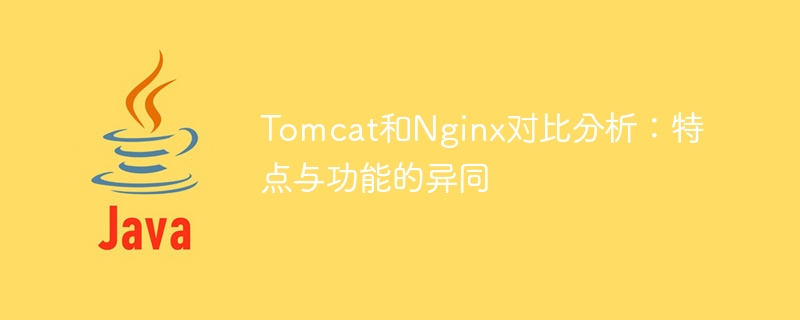
Tomcat and Nginx are two common web server software that are widely used in the deployment and management of web applications. Although they are both software for the Web server field, they are significantly different in some aspects. This article will conduct a comparative analysis of the features and functions of Tomcat and Nginx to better understand their similarities and differences.
- Feature comparison
Tomcat is an open source web server based on Java. It is a management container for Java Servlets and JavaServer Pages (JSP). Tomcat has the following characteristics:
- Supports Java technology: As a Java Web server, Tomcat can fully support Java technology, including Java Servlet, JSP and Java applications.
- Easy to use: Tomcat is relatively easy to configure and use, suitable for developers and system administrators. It provides simple command line tools and concepts to facilitate user operations.
- Scalability: By supporting the deployment and management of web applications, Tomcat allows users to customize and expand the server according to their needs.
- Multi-platform support: Tomcat can run under various operating systems, including Windows, Linux and Mac OS, etc.
Nginx is a high-performance open source web server and reverse proxy server. It has the following characteristics:
- High concurrency processing capabilities: Nginx has excellent concurrency processing Ability to effectively handle a large number of concurrent requests, suitable for high-load Web service environments.
- Lightweight design: Nginx design is simple and lightweight, occupies relatively few resources, and can effectively support large-scale concurrent connections without occupying too many system resources.
- Reliability and stability: Nginx ensures high availability and stability through configuration policies and working modes, and can quickly recover from hardware failures, network interruptions and other problems.
- As a reverse proxy: Nginx can also be used as a load balancer and reverse proxy server, providing higher performance and security.
- Function comparison
Tomcat and Nginx also have some obvious functional differences.
- Tomcat is mainly used for the deployment and management of Java applications. It supports the Java technology stack and can handle JSP pages and Java Servlets. Tomcat also provides some implementations of JavaEE standards, such as JavaMail and Java Persistence API.
- Nginx is more suitable for use as a web server and reverse proxy server. Nginx supports protocols such as HTTP, HTTPS, and TLS/SSL, and provides efficient load balancing and reverse proxy functions. Nginx can also be configured with caching and compression to provide high-speed access to static resources, thus improving the performance of web applications.
- In addition, Nginx also supports dynamic modules and plug-in mechanisms, and its functions can be expanded through customized modules to meet the needs of different scenarios.
- Comparison of similarities and differences
Tomcat and Nginx have significant similarities and differences in the following aspects.
- Support for Java: Tomcat is specially designed for Java applications. It provides complete Java technical support and can easily deploy and manage Java applications. Nginx has weak support for Java. It is usually used to proxy Java applications and forward requests to Tomcat for processing.
- Ability to handle static resources: Tomcat is relatively weak in handling static resources, and its main focus is on the support of Java technology. Nginx, on the other hand, focuses on efficiently processing static resources and improves performance through caching and compression.
- Concurrent processing capabilities: Nginx has excellent concurrent processing capabilities in high-load environments through event-driven asynchronous processing. Tomcat uses multi-threading to process requests, which is relatively slow.
- Function positioning: Tomcat is mainly used for the deployment and management of Java applications, providing a complete Java Web application development environment. Nginx is more used for web servers and reverse proxy servers, and its positioning is more versatile.
To sum up, there are some obvious similarities and differences between Tomcat and Nginx in their features and functions. Choosing the right server software depends on specific needs and scenarios. If you need to deploy and manage Java applications, Tomcat is a more suitable choice; while Nginx is more suitable for high-concurrency environments, reverse proxy and load balancing requirements. No matter which server software you choose, it needs to be evaluated and adjusted according to the actual situation to ensure the performance and stability of the server.
The above is the detailed content of Tomcat and Nginx: Comparative Analysis of Features and Functions. For more information, please follow other related articles on the PHP Chinese website!


 nginx restart
nginx restart
 Detailed explanation of nginx configuration
Detailed explanation of nginx configuration
 Detailed explanation of nginx configuration
Detailed explanation of nginx configuration
 How to configure Tomcat environment variables
How to configure Tomcat environment variables
 What are the main characteristics of computers?
What are the main characteristics of computers?
 How to integrate idea with Tomcat
How to integrate idea with Tomcat
 How to view Tomcat source code
How to view Tomcat source code
 What are the common tomcat vulnerabilities?
What are the common tomcat vulnerabilities?




